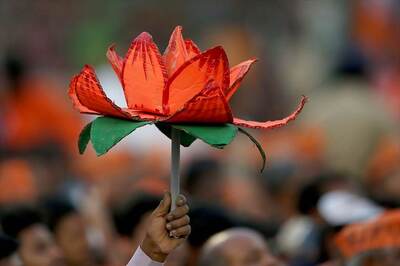
views
The formation of SATHI, as a part of an electoral alliance in Uttar Pradesh and the selection of a separate symbol for its campaign in the state is an interesting example of the changes that are taking place in Indian electoral politics these days.
In Uttar Pradesh, Samajwadi Party (SP), Bahujan Samaj Party (BSP) and Ajit Singh–led Rashtriya Lok Dal (RLD) have forged an alliance for 2019 Lok Sabha elections. This new alliance is named as SATHI. Interestingly, that SA of this SATHI has been borrowed from the initial two letters of Samajwadi Party and the THI part of this nomenclature has been extracted from Hathi (elephant), the electoral symbol of Bahujan Samaj Party.
One can witness another interesting scene during election campaigns of these political parties. The candidates of these parties do seek votes on the electoral symbols of their respective parties, but they also have a separate symbol for the canvassing. The story of the creation of such kind of separate symbol too points out an internal jostling for symbols within Indian polity.
The symbol of SATHI is comprised of the wheel of Samajwadi Party’s cycle and the trunk of Bahujan Samaj Party’s elephant. But instead of adding any part of the Rashtriy Lok Dal’s hand –pump into it, the spokes of the cycle wheel have been painted green. The RLD, of late, has been running a campaign for a separate Harit (Greenery) Pradesh in western Uttar Pradesh. The green colour of cycle spokes symbolizes that greenery.
In fact, several unique experiments of coining new kind of phrases, signs and symbols by the political parties for their respective politics are being witnessed these days.
During his campaigning for assembly elections in Uttar Pradesh, BJP president Amit Shah had deduced a new terminology of KASAB by taking first Hindi letters of Congress, Samajwadi Party and Bahujan Samaj Party. KASAB is considered as one of the perpetrators of 26/11 attacks in Mumbai and the BJP used his name as a perfect tool of polarisation for its communal nationalism.
The way Indian electoral politics is minutely changing at the ground level, it is being reflected through words, signs and symbols. But the way the leadership of Indian political parties are behaving and taking their decisions as a landlord who just survives on the rent he receives from his tenant, it’s the most modern face of Indian politics.
Janata Dal (S) general secretary Danish Ali had played a crucial role in installing a coalition government of Congress, Janata Dal (S) and Bahujan Samaj Party (BSP) in Karnataka. But few days ago, the same Ali switched sides from JD (S) to BSP. The media showcased this news as if he quit JD (S) and joined BSP with the consent of his erstwhile party leadership. Quite clearly, the BSP leadership too was aware of this fact. Getting disgruntled with one party and joining other is a common phenomenon of Indian politics. But these days, leaders of one particular party are joining another party with the consent of the leadership of his former party. This is an example of “post multi – party democracy” or ‘multi-parties-one-politics-democrary’.
The case of Ali joining a new party with the consent of the leadership of his former party is not an isolated one. This has become a common trend of consent and acceptance. Bihar chief minister Nitish Kumar had surprised scribes by informing them that he had inducted Prashant Kishore into his party (Janta Dal –United) fold on the advice of BJP chief Amit Shah. There is a hype about Kishore that the electoral prospects of whichever party he sides with get bolstered because of his unique campaigning design. Kumar has nominated him as national vice president of Janta Dal –United.
It is commonly seen in Indian politics that groups related to capitalist, socialist, communal and secular ideologies remain simultaneously active within a particular political party. The Rashtriya Swayamsevak Sangh (RSS) plants its pracharak in Bharatiya Janata Party. For example, currently Ram Madhav is seen as a representative of Sangh in BJP.
It has also been observed in Indian politics that a dissident group in a particular party prepares a base for itself by remaining active in a social, caste – based and religious organisations outside its party. Though after the implementation of anti – defection law, introduced by Rajiv Gandhi government, new kind of distortions and anomalies have cropped up. The list of such loopholes is going endless. Earlier, there used to be several power centres in a particular political party. But now the parties have unitary leaderships and with the consent and clearance of such leadership politicians working under them may remain in other parties.
In electoral politics, another trend is also coming to fore that a candidate of one particular party is contesting on the symbol of another party. In the bypoll of Kairana Lok Sabha constituency of Uttar Pradesh, Tabassum Hassan of Samajwadi Party was fielded on the symbol of Rashtriya Lok Dal. The proposal for the candidature of Tabassum Hassan was mooted by Rashtriya Lok Dal leader Jayant Chaudhary himself. This formula is being implemented in various states for upcoming parliamentary polls as well. In Bihar, the Rashtriya Janata Dal (RJD) leadership has put a condition before veteran politician Sharad Yadav to contest election on its symbol. It’s another matter that Yadav, after separating from JD (U), has formed his own political outfit with a symbol of clarion.
Similar condition has also been put up by the Nationalist Congress Party (NCP) – Congress combine before Prakash Ambedkar in Maharashtra. This is entirely a new culture in alliance politics. Perhaps, this results in keeping one party stick together with the other party longer. Actually, under anti – defection law, a candidate is forced to obey the whip and directives of the party on whose election symbol he or she contests election and emerges victorious.


















Comments
0 comment